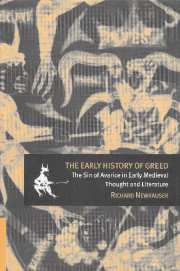Book contents
- Frontmatter
- Contents
- List of abbreviations
- Preface
- 1 Alms and ascetes, round stones and masons: avarice in the early church
- 2 Ascetic transformations I: monks and the laity in eastern Christendom
- 3 Ascetic transformations II: soaring eagles or safety in the herd – from anchoritic to cenobitic monasticism
- 4 Ascetic transformations III: the Latin West in the fourth and fifth centuries
- 5 Secularizing avarice and cupidity
- Epilogue: Future perspectives
- Appendix
- Notes
- Bibliography
- General index
- Index of names
- CAMBRIDGE STUDIES IN MEDIEVAL LITERATURE
3 - Ascetic transformations II: soaring eagles or safety in the herd – from anchoritic to cenobitic monasticism
Published online by Cambridge University Press: 22 September 2009
- Frontmatter
- Contents
- List of abbreviations
- Preface
- 1 Alms and ascetes, round stones and masons: avarice in the early church
- 2 Ascetic transformations I: monks and the laity in eastern Christendom
- 3 Ascetic transformations II: soaring eagles or safety in the herd – from anchoritic to cenobitic monasticism
- 4 Ascetic transformations III: the Latin West in the fourth and fifth centuries
- 5 Secularizing avarice and cupidity
- Epilogue: Future perspectives
- Appendix
- Notes
- Bibliography
- General index
- Index of names
- CAMBRIDGE STUDIES IN MEDIEVAL LITERATURE
Summary
THE CAPITAL VICE TRADITION: EVAGRIUS PONTICUS AND THE EVIL THOUGHT OF GREED
The absolute rejection of an individual's possession of wealth, an attitude which remained an influential component in the Christian imagining of avarice, found its most analytic and organized expression initially among the ascetes who retired to the Egyptian desert in the fourth and fifth centuries to perfect their spiritual life. Their rise to prominence, and with them the power of their ascetic ideal and their poverty, signaled vast changes to come in Roman society on its way to the Christian Middle Ages. The conception of material goods and greed developed by Evagrius Ponticus and John Cassian, the most important hamartiological theorists to emerge from this monastic movement, was influenced by the earlier ideas of their instructors in spiritual matters among the Cappadocians and by the thinking of John Chrysostom: Evagrius was ordained a lector by Basil the Great and made a deacon by Gregory Nazianzen, and Cassian was under the tutelage of John Chrysostom. Yet their imagining of avarice progressed, in effect, in the opposite direction from that of their predecessors, for whereas each of the church thinkers examined in Chapter 2 went from ascesis to the episcopacy in the course of his career, Evagrius and Cassian moved from positions within the ecclesiastical administration to life in an ascetic community by the end of their careers. It was also exclusively for these monastic groups that they composed their treatises.
- Type
- Chapter
- Information
- The Early History of GreedThe Sin of Avarice in Early Medieval Thought and Literature, pp. 47 - 69Publisher: Cambridge University PressPrint publication year: 2000



